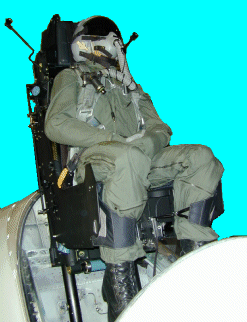The Ejection Site
Martin-Baker Mk. 16
 The Joint Strike Fighter has been selected to be built by a consortium headed by Lockheed-Martin Aircraft and will use the Martin-Baker Mk. 16 ejection seat.
Boeing which headed up a rival consortium in the prototype evaluation phase had also selected the Mk. 16 seat. This seat is a radically different seat from
earlier Martin-Baker designs.
This page shows an early seat based on the Mk 16A that was displayed by Martin-Baker. The seat as used in the JSF can be seen on this page.
Using technology developed in the Mk. 15 lightweight trainer seat, the main beam assembly has been replaced by two sets of
telescoping tubes which double as the catapult system. A common gas generator provides the force to catapult the seat/man package out of the cockpit. A newly
developed underseat rocket system is used for sustained propulsion.
The Joint Strike Fighter has been selected to be built by a consortium headed by Lockheed-Martin Aircraft and will use the Martin-Baker Mk. 16 ejection seat.
Boeing which headed up a rival consortium in the prototype evaluation phase had also selected the Mk. 16 seat. This seat is a radically different seat from
earlier Martin-Baker designs.
This page shows an early seat based on the Mk 16A that was displayed by Martin-Baker. The seat as used in the JSF can be seen on this page.
Using technology developed in the Mk. 15 lightweight trainer seat, the main beam assembly has been replaced by two sets of
telescoping tubes which double as the catapult system. A common gas generator provides the force to catapult the seat/man package out of the cockpit. A newly
developed underseat rocket system is used for sustained propulsion.
The seat was designed with the more expanded occupant weights in mind and the new propulsion systems are within tolerances for the 3 percentile to 97 percentile
occupant. The seat bucket features additional adjustment for comfort as well as to assure a small occupant can reach all the necessary controls. A version of
this seat is flying in the T-6A Texan II aircraft, and has already saved the lives of two crewman in that aircraft.
A digital computer controls sequencing of the seat for effective recovery of the occupant for all expected speed ranges. The seat uses a passive leg restraint
system akin to the one used on several Russian seats like the K-36-series. This system consists of a set of restraint lines run around the cockpit leg areas
so that the pilot merely places his/her feet on the rudder pedals. These straps are connected to a padded cuff which is stowed on the sides of the seat pan.
On ejection the lines are retracted which wraps the cuffs around the lower limbs of the occupant and provides protection against flail injury.
The seat uses a rapid deploying drogue parachute to slow and stabilize the seat during high-speed ejections. The seat bucket is mostly composite materials.
This and the changes to the configuration lower the weight of this seat over prior versions significantly. The main recovery parachute is installed in the headrest.
The version in these photos uses pop-out pitot tubes for airspeed reading. The later Mk US16E has a sequencer that uses accelerometers instead.
The following photographs were taken at a couple of airshows by Chris Woodul and show a Mk. 16 which was displayed with a sled test
cockpit mockup and a manikin wearing representitive flight gear.
 The Joint Strike Fighter has been selected to be built by a consortium headed by Lockheed-Martin Aircraft and will use the Martin-Baker Mk. 16 ejection seat.
Boeing which headed up a rival consortium in the prototype evaluation phase had also selected the Mk. 16 seat. This seat is a radically different seat from
earlier Martin-Baker designs.
This page shows an early seat based on the Mk 16A that was displayed by Martin-Baker. The seat as used in the JSF can be seen on this page.
Using technology developed in the Mk. 15 lightweight trainer seat, the main beam assembly has been replaced by two sets of
telescoping tubes which double as the catapult system. A common gas generator provides the force to catapult the seat/man package out of the cockpit. A newly
developed underseat rocket system is used for sustained propulsion.
The Joint Strike Fighter has been selected to be built by a consortium headed by Lockheed-Martin Aircraft and will use the Martin-Baker Mk. 16 ejection seat.
Boeing which headed up a rival consortium in the prototype evaluation phase had also selected the Mk. 16 seat. This seat is a radically different seat from
earlier Martin-Baker designs.
This page shows an early seat based on the Mk 16A that was displayed by Martin-Baker. The seat as used in the JSF can be seen on this page.
Using technology developed in the Mk. 15 lightweight trainer seat, the main beam assembly has been replaced by two sets of
telescoping tubes which double as the catapult system. A common gas generator provides the force to catapult the seat/man package out of the cockpit. A newly
developed underseat rocket system is used for sustained propulsion.